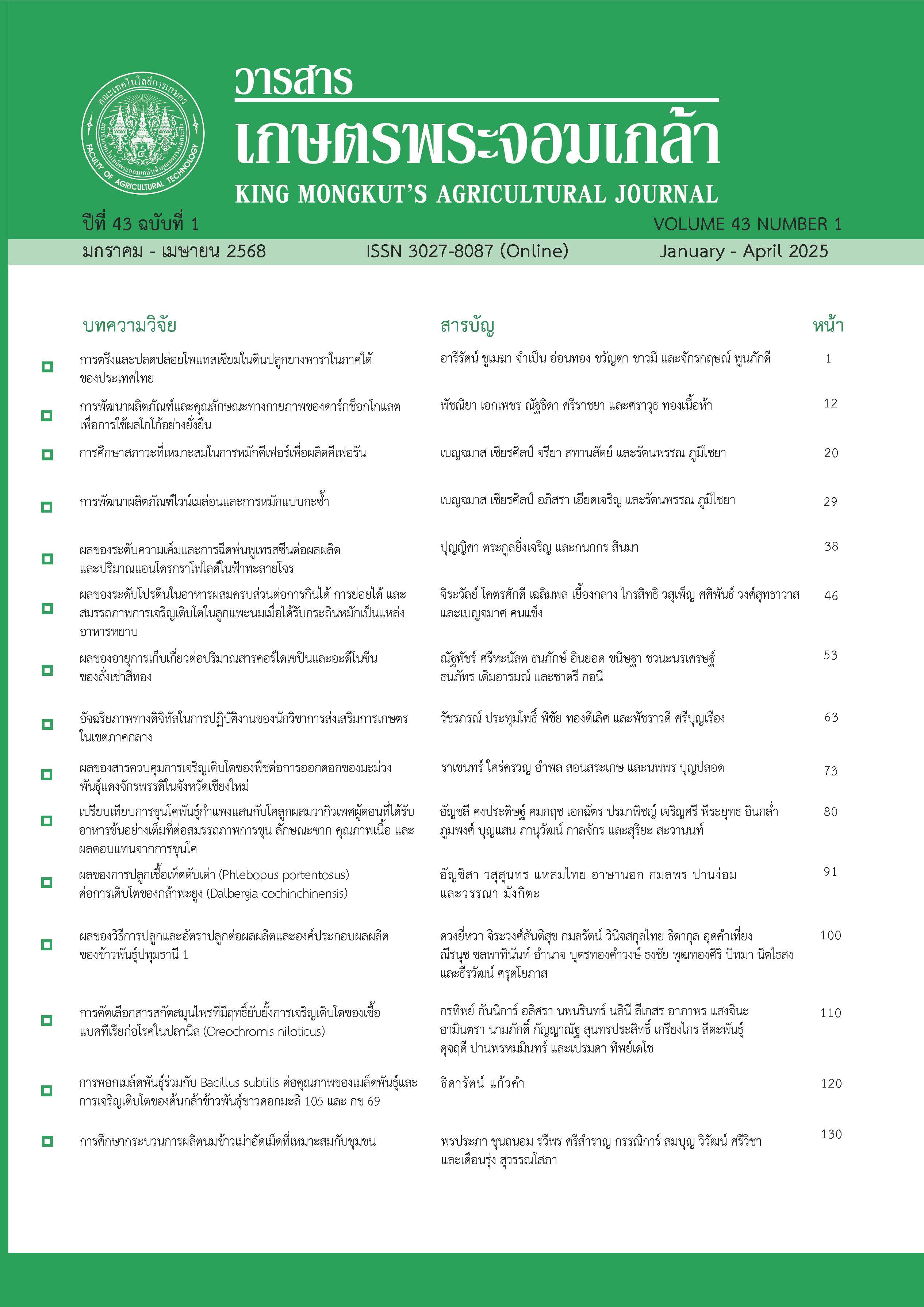การศึกษาสภาวะที่เหมาะสมในการหมักคีเฟอร์เพื่อผลิตคีเฟอรัน
Main Article Content
บทคัดย่อ
คีเฟอร์เป็นนมหมักพื้นเมืองที่มีต้นกำเนิดจากชาวคอเคซัส (Caucasian) มีคุณสมบัติที่มีประโยชน์ มีรสเปรี้ยว และมีแอลกอฮอล์ผสมอยู่ด้วย ซึ่งเกิดจากการหมักโดยแบคทีเรียและยีสต์ที่ฝังตัวอยู่ในก้อนเชื้อที่เรียกว่าคีเฟอร์เกรน โดยการหมักคีเฟอร์จะทำให้เชื้อแบคทีเรียแลคติกในก้อนเชื้อผลิตสารเมือกเหนียวที่เรียกว่าคีเฟอรัน จากการศึกษาการผลิตคีเฟอรันโดยการหมักคีเฟอร์เกรนสองแบบ คือ คีเฟอร์เกรนน้ำที่เลี้ยงด้วยน้ำมะพร้าวและคีเฟอร์เกรนนมที่เลี้ยงด้วยนมสด พบว่าคีเฟอร์เกรนนมมีความสามารถในการผลิตคีเฟอรันและกรดแลคติกได้มากกว่าคีเฟอร์เกรนน้ำมะพร้าว ในขณะที่คีเฟอร์น้ำมะพร้าวให้การผลิตเอทานอลสูงกว่า และพบว่าการหมักที่อุณหภูมิ 30 องศาเซลเซียส ทำให้คีเฟอร์เกรนน้ำมะพร้าวผลิตคีเฟอรัน กรดแลคติก และเอทานอลสูงกว่าการหมักที่อุณหภูมิ 37 องศาเซลเซียส ในขณะที่คีเฟอร์เกรนนมให้การผลิตคีเฟอรันและกรดแลคติกใกล้เคียงกันทั้งที่อุณหภูมิ 30 และ 37 องศาเซลเซียส แต่ที่อุณหภูมิ 30 องศาเซลเซียส ให้การผลิตเอทานอลสูงกว่าที่อุณหภูมิ 37 องศาเซลเซียส และพบว่าปริมาณหัวเชื้อคีเฟอร์เกรนนมเริ่มต้นที่ร้อยละ 1 โดยน้ำหนักคีเฟอร์เกรนเปียกต่อปริมาตรนม และการหมักแบบไม่เขย่า ให้การผลิตคีเฟอรันได้สูงสุดเท่ากับ 73.63 มิลลิกรัมต่อปริมาตรนม 120 มิลลิลิตร ซึ่งสภาวะที่เหมาะสมที่ได้จากการศึกษานี้สามารถใช้เป็นแนวทางในการผลิตคีเฟอรันโดยการหมักคีเฟอร์ได้
Article Details

อนุญาตภายใต้เงื่อนไข Creative Commons Attribution-NonCommercial-NoDerivatives 4.0 International License.
วารสารเกษตรพระจอมเกล้า
เอกสารอ้างอิง
Apar, D. K., Demirhan, E., Özel, B., & Özbek, B. (2017). Kefir grain biomass production: Influence of different culturing conditions and examination of growth kinetic models. Journal of Food Process Engineering, 40(1), e12332.
Arslan, S. (2015). A review: chemical, microbiological and nutritional characteristics of kefir. CyTA-Journal of Food, 13(3), 340-345.
Cheirsilp, B., & Radchabut, S. (2011). Use of whey lactose from dairy industry for economical kefiran production by Lactobacillus kefiranofaciens in mixed cultures with yeasts. New Biotechnology, 28(6), 574-580.
Cheirsilp, B., Shoji, H., Shimizu, H., & Shioya, S. (2003). Interactions between Lactobacillus kefiranofaciens and Saccharomyces cerevisiae in mixed culture for kefiran production. Journal of Bioscience and Bioengineering, 96(3), 279-284.
Dailin, D. J., Elsayed, E. A., Othman, N. Z., Malek, R. A., Ramli, S., Sarmidi, M.R., Aziz, R., Wadaan, M. A., & El Enshasy, H. A. (2015). Development of cultivation medium for high yield kefiran production by Lactobacillus kefiranofaciens. International Journal of Pharmacy and Pharmaceutical Sciences, 7(3), 159-163.
Dimitreli, G., Exarhopoulos, S., Goulas, A., Antoniou, K. D., & Raphaelides, S. N. (2016). Effect of kefiran and milk proteins addition on the rheological behavior of glucono-deta-lactone induced milk gels. Journal of Food Research, 5(1), 121-128.
Fels, L., Jakob, F., Vogel, R. F., & Wefers, D. (2018). Structural characterization of the exopolysaccharides from water kefir. Carbohydrate Polymers, 189(1), 296-303.
Laureys, D., & De Vuyst, L. (2017). The water kefir grain inoculum determines the characteristics of the resulting water kefir fermentation process. Journal of Applied Microbiology, 122(3), 719-732.
Setiawati, A. E., Sari, I. N. I., & Hasyati, N. (2021). Effect of temperature and time storage towards alcohol level in cow milk kefir. In International Conference on Green Agro-industry and Bioeconomy, pp. 012108. Faculty of Agricultural Technology, Universitas Brawijaya.
Suksawang, S., Cheirsilp, B., & Yeesang, J. (2016). Production of kefiran from molasses and spent yeast cells by Lactobacillus kefiranofaciens JCM 6985. Asia-Pacific Journal of Science and Technology, 21(2), 59–67.
Zajšek, K., & Goršek, A. (2010). Mathematical modelling of ethanol production by mixed kefir grains yeast population as a function of temperature variations. Biochemical Engineering Journal, 49(1), 7-12.
Zajšek, K., Goršek, A., & Kolar, M. (2013). Cultivating conditions effects on kefiran production by the mixed culture of lactic acid bacteria imbedded within kefir grains. Food Chemistry, 139(1-4), 970-977.


